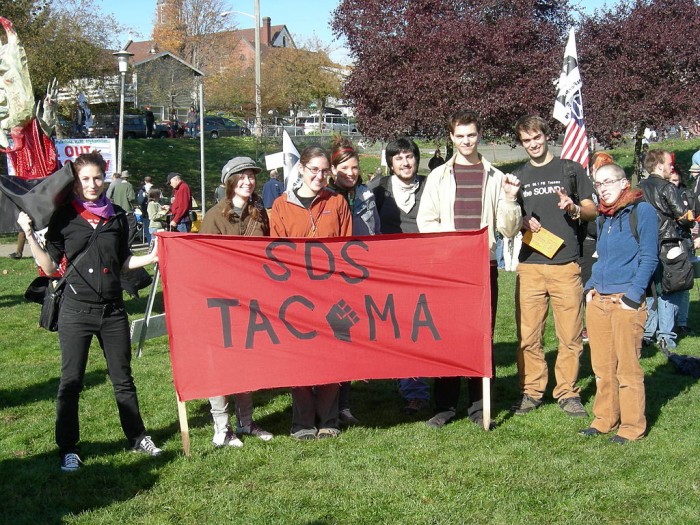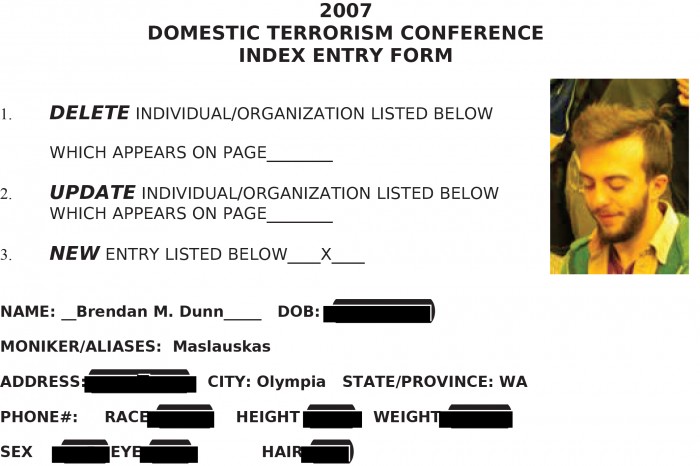
Did you think the government stopped infiltrating peaceful anti-war groups in the ‘60s?
Think again.
One of the most important cases of domestic spying in decades just happened right here in the Pacific Northwest. The saga began in 2007 when activists began protesting the use of public ports in Tacoma and Olympia to transport tanks and other military equipment overseas.
John J Towery II, a civilian employee of the US Army working in the Force Protection Division at Fort Lewis, was tasked with making sure the shipments made it safely to port.
Public records indicate that he spied on Pacific Northwest activists for the US Army and for the Regional Intelligence Group 5 (RIG5) of the Washington State Fusion Center (WSFC), which serves as an information hub for federal, state and local law enforcement, allowing agencies to share information about threats, including domestic terrorism.
Timeline of the Towery case
Between 2006 and 2009 Towery attended activist meetings, protests and social functions.
He became friends with other group members and would visit their homes, stepping outside occasionally to send email updates to his supervisors.
But then he got caught.
The activists who unmasked Towery used counter-surveillance tactics that could serve as a manual for other groups looking to weed out unconstitutional government spy operations.
Here’s how they did it: In the wake of a wave of mysterious arrests for “attempted civil disobedience” in November 2007, members of the peace activism groups Port Militarization Resistance and Students for a Democratic Society filed public records requests that ultimately resulted in the release of a trove of documents revealing that Towery had been attending meetings as a spy.
A group of activists filed suit against Towery in 2010, alleging that his infiltration of their peaceful political meetings violated their 1st and 4th Amendment rights and the Posse Comitatus Act, a law intended to keep the military from engaging in domestic law enforcement.
“JBLM does not have a comment,” wrote Joint Base Public Affairs Officer Joseph J. Piek in an email. “John Towery no longer works for the U.S. Army, and he is no longer at JBLM.”
Panagacos v. Towery was dismissed June 18 by U.S. District Judge Ronald B. Leighton, but the plaintiffs filed an appeal July 16th.

Five things we’ve learned about domestic spying from Panagacos v. Towery:
1) The intelligence community thinks all sorts of people are worth watching
If you’ve participated in a political action in the Pacific Northwest in the last decade, your name is probably on a list somewhere. Documents obtained by Drew Hendricks, a Pacific Northwest activist, show that Sgt. Chris Adamson and his colleagues at the Washington State Fusion Center targeted individuals for surveillance for many reasons, such as:
- riding Harley Davidson motorcycles
- buying fertilizer while Pakistani
- attending vigils outside the Northwest Detention Center
- being romantically or socially linked to suspect groups
- visiting houses where alleged anarchists lived
2) The army spied on peaceful activists on US soil
Towery originally denied engaging in spying in the course of his duties as an employee of the army.
“I went largely out of personal curiosity. I have a degree in psychology and have always had an interest in why people do the things they do,” he told army investigators when news of his infiltration first broke in 2009.
In a March 28 2014 deposition Towery changed his story, admitting that he was on the army payroll and working during the Port Militarization Resistance meetings that he attended under the alias John Jacob between May 2007 and July 2009.
Towery explained that Sgt. Adamson approached him at a meeting in 2007 and asked if he would be able to share information with the WSFC.
He agreed to do so in an email, later formalizing the agreement by signing on as a confidential source reporting to Adamson.
“The primary purpose of my attending [protests] was to develop threats or potential actions against soldiers and the movements [of military equipment],” said Towery in the deposition. “Any ancillary information that I received that could have been a possible officer safety issue or anything else like that, then, yes, I would report it to Detective Adamson.”
Adamson, who still works for the Pierce County Sheriff’s Dept., declined to be interviewed for this story.
3) The Washington State Fusion Center claims to know nothing

The whole idea behind the WSFC is to connect information between agencies. But as soon as this case came to light, the WSFC denied any connection.
The WSFC has consistently distanced itself from the Towery debacle since the story broke. Sgt. Craig H Johnson, a detective with the Washington State Patrol, said, “Adamson didn’t work for the Washington State Fusion Center, he was part of a regional intelligence group out of Tacoma.”
Johnson said he has some awareness of the Panagacos v. Towery suit due to media coverage, but he doesn’t believe that Adamson was directly affiliated with the WSFC or that they knew anything about Towery. Johnson was not working with the WSFC in 2009 and may not have been informed about the Towery case.
The links between Adamson and the WSFC prior to 2009 are rock solid, though. His employment history includes a past position as Director of the Regional Intelligence Group 5 for the Washington State Fusion Center.
An internal email sent in July 2009 reveals a degree of panic following the media debut of the Towery situation. The message was sent to various local law enforcement media contacts by from Department of Homeland Security Officer James Szrama.
“My comments have been we don’t know who this guy is (I assume this is still true),” wrote Szrama. “Second we don’t know why he would say he is reporting to the fusion center. Other then there may be regional guys (RIGS) who mayhave [sic] talked to him. THEY MENTION WAJAC in the text!”
WAJAC stands for the Washington Joint Analytical Center, the previous name of the WSFC. The name change occurred in 2009, after activists requested records revealing Towery was a spy but before they received them.
“This could kill us,” Szrama added before signing off.
4) Government agents trying to infiltrate political groups aren’t always smooth or sophisticated

“I believe Towery was so low level as to be out of the distribution of the Army’s “real” spy network, so he went off on his own foolish efforts in coordination with the local “Fusion Center” sponsored intelligence group,” explained Drew Hendricks, the activist who requested the documents that exposed Towery.
“Because spying on U.S. Persons is not legal for the Army, and because spying on U.S. Persons is also so politically sensitive, I believe it is normally done mostly by Psyops troops,” Hendricks wrote in an email, noting that he suspects he has met between five and seven of the professional army spy types in the last decade, not including Towery.
Towery didn’t arouse Hendricks’ suspicion because he didn’t engage in tactics typically associated with infiltrators.
“Part of why I trusted him was that he never asked me to commit any criminal activity,” said Hendricks.
“I considered him a close friend, a fellow activist, a fellow organizer,” said Brendan Maslauskas Dunn, one of the activists who Towery spied on. “The revelation that he was an army spy hit me pretty hard.”
5) Activists can fight back by documenting everything
“Don’t tear groups apart out of fear of infiltrators, don’t let them take your focus off your goals,” said Larry Hildes, the National Lawyers Guild attorney representing the plaintiffs in the Towery case.
“Just be careful and don’t say anything you wouldn’t want repeated to law enforcement unless you really trust the people you’re talking with. Our discovery of Towery’s role has given us the tools to carefully document a much wider system of police intelligence in great detail.”
Hildes offered some advice for activists looking to avoid infiltration: “Make sure you know everyone. Check people out quietly, verify that people coming in actually know who they say they do. If you have suspicions about someone, do not make a public issue without proof; talk with someone you trust and quietly verify that they are who they say they are.”
What next?
An appeal was filed July 16 with the United States Court of Appeals for the Ninth Circuit, the same court that found in Panagacos’ favor on a similar appeal in November 2012.
Hildes is hopeful about the appeal, saying, “we wouldn’t bring it if we didn’t think it would succeed.”


One thing to keep in mind is that this story didn’t end when Towery was caught; his office still reports on demonstrations, coordinating surveillance of them and sometimes spurring arrests. See the web site link above for just one example. See Strife’s ‘Works In Progress’ articles for more examples.
Great link, Drew, thanks for adding it!
I am from MN. There is a fusion center here as well. It appears as if I was targeted by one of the centers, but got passed onto a different center/organization that deals with people a little bit more harshly. I have reason to believe it is in Colorado, and I have reason to believe there are some harsh criminal undertones here, with a more nihilistic approach than a standard police force.
The fusion center seems carry ALL electronic papertrail on everyone, including phone data and all gps locations. Not just terrorism targets. This would be a complicated system to create, but easy to maintain. It appears as if the NSA is nothing more than a computer operating system, like windows or linuex, and it is accesible to specific individuals and groups.
I have good reason to believe that people are being targeted through fusion centers, and the fusion center is able to motivate people into creating public events and organizing small groups of neighborhood watch. These people may have good intentions, but it sure is rough on the brain. It is exhausting as well. I heard this was called “multi stalking”.
But there are many degrees of this type of stalking, and some are clearly more harsh than others. I dont think people are reading enough into this who spying thing, because I think the fusion centers have adapted themselves and elaborated into our culture over the course of like the past 10-15 years. It is obvious that people are having a hard time understanding that this whole fusion center thing, isnt such a good idea and it could have lethal consequences for specific people.